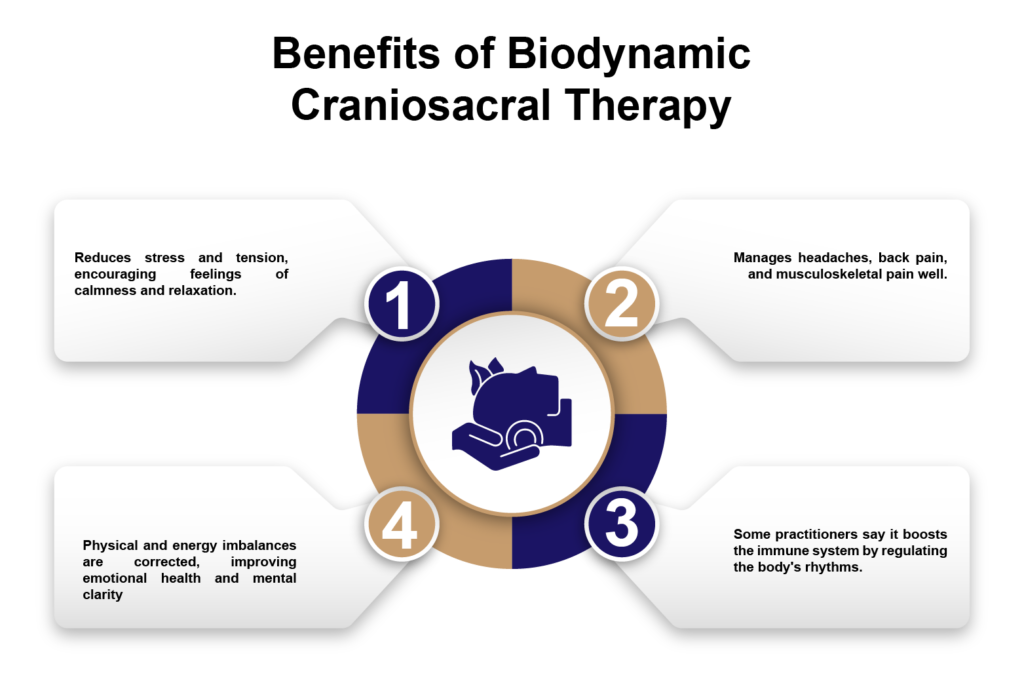Bright Point MD cares about your health and fitness. Our organization in peaceful Largo, Maryland, helps people reach their full wellness potential through holistic methods. We discuss craniosacral therapy, one of our specialties. We’ll show you how this alternative therapy fits our holistic health and life-improvement goals.
Alternative therapies are of the utmost importance in our modern world, when stress and tension can harm our bodies and minds. Bright Point MD knows that conventional medicine is not the only way to be healthy. We provide a variety of holistic therapies, including craniosacral therapy that is particularly effective for recovery, relaxation, and self-healing.
Come along with me on this journey. Discover craniosacral therapy, how it can improve your physical, mental and emotional health, and how to experience its tremendous advantages.

What Is Craniosacral Therapy?
Addressing dementia’s unique requirements requires personalized care programs. These plans cover medical, psychological, and social treatment. A good care plan considers cognitive ability, physical health, emotional health and wellness, and personal preferences.
The Basics Of Craniosacral Treatment Are:
1. Craniosacral Rhythm
The therapy focuses on the delicate, rhythmic pulsation of cerebrospinal fluid through the craniosacral system. Therapists use their educated hands to detect and manipulate this rhythm for balance.
2. Release of limitations
CST practitioners locate craniosacral tension, compression, and limitation. They use gentle pressure and subtle movements to loosen these limitations and let the body recuperate.
Craniosacral Treatment Has Several Physical and Mental Benefits:
Physical Benefits
CST can relieve chronic pain, headaches, and musculoskeletal disorders. It may also increase mobility and flexibility.
Mental and Emotional health
Craniosacral therapy reduces stress, anxiety, and improves mental clarity. Sessions often leave clients feeling deeply calm and peaceful.
Bright Point MD Craniosacral Therapists' Competence
Bright Point MD is dedicated to craniosacral therapy excellence. We know our craniosacral therapists’ ability and experience are essential for the success of your therapy sessions. We’re proud to introduce you to our committed team of professionals who will help you enhance the quality of your life.
What Does a Craniosacral Therapist Do?
A trained craniosacral therapist specializes in CST. They use mild, non-invasive craniosacral procedures to help the body repair itself.
What a craniosacral therapist does
1. Assessment
During craniosacral therapy, the client’s craniosacral system is assessed first. They sense delicate rhythms and system strain or restriction with their educated hands. Assessments underpin therapeutic sessions.
2. Hands-On Techniques
The soft, hands-on nature of craniosacral therapy is important. Therapists gently touch and manipulate the head, spine, and sacrum. These methods relieve limitations, increase cerebrospinal fluid flow, and restore balance.
3. Balancing the Craniosacral Rhythm
The natural cerebrospinal fluid pulsation is balanced by craniosacral therapists. They seek to enhance the body’s self-healing.
4. Holistic Approach
CST approaches wellness holistically, knowing that physical and emotional health are linked. Therapists assess clients’ physical, emotional, and psychological wellness.
How Can Visiting a Craniosacral Therapist Benefit You?
There are many benefits some of them are listed below:
1. Stress Reduction
Craniosacral treatment is known for its deep relaxing effects. It can soothe people by lowering stress and tension.
2. Pain relief or comfort
Many clients seek craniosacral therapy for chronic pain relief, such as headaches, back pain, and musculoskeletal discomfort. Our therapists employ gentle approaches to relieve pain and promote comfort.
3. Increased Mobility and Flexibility
CST reduces craniosacral system limitations, improving mobility and flexibility. Those with movement difficulties or recuperating from injuries may benefit.
4. Improved Mental Clarity
Craniosacral therapy can increase mental clarity and focus by promoting relaxation. Clients report feeling more grounded and ready for life’s difficulties.
5. Holistic Wellness
We prioritize treating the full person, not just symptoms. Our craniosacral therapists address physical and mental health holistically.
How to Become a Craniosacral Therapist
Being a craniosacral therapist is satisfying because you help people attain physical and emotional equilibrium through gentle touch and manipulation. To follow this course, you must grasp the steps and conditions. The following section discusses the requirements to become a qualified craniosacral therapist, emphasizing the importance of education. Read more
Educational Requirements
Education is key to a successful craniosacral therapy profession. No prior schooling is required, however a background in healthcare, anatomy, or similar subjects is helpful. Anyone with a love for craniosacral therapy can pursue this job.
1. High School Education
Starting with a high school diploma or equivalent. A solid science, biology, and anatomy education can facilitate craniosacral therapy.
Undergraduate Degree
Some people choose to get a bachelor’s degree in biology, psychology, or physical therapy to learn more about the body. This can help but is not necessary.
Specialized Training Programs
Specialized training is required to become a craniosacral therapist. These programs give practitioners the knowledge and skills they need.
1. Classes in Craniosacral Therapy
Find accredited craniosacral therapy programs. These courses address anatomy, physiology, cranial anatomy, and craniosacral therapy hands-on.
2. A clinical practicum
Clinical practicums give students firsthand experience working with clients under supervision in many training programs. This practical instruction is crucial for skill development.
3. The certification
Upon completion of an approved training program, craniosacral therapists can be certified. Certification criteria vary by location and body.
Continuing Education
Craniosacral treatment evolves. Practitioners must continue their education and development. Therapists can stay current on industry trends and procedures. Proper training equips therapists to treat clients safely and effectively. It also gives clients confidence that they are receiving professional care.
Craniosacral therapy requires study and practice. No specific schooling requirements exist, but specialized training and certification are essential to succeed in this sector.
Why Biodynamic Craniosacral Therapist Do
Biodynamic Craniosacral Therapy uses the body’s inherent healing process to treat the whole person. Based on osteopathy and craniosacral treatment, it emphasizes the system’s role in health. The practitioner uses their hands to observe and promote the body’s natural rhythms and movements in this gentle, non-invasive therapy.
Unique Approach and Benefits
Biodynamic Craniosacral Therapy points out the body’s wisdom, unlike conventional medicine.It aids the body’s healing rather than imposing alterations.
Benefits of Biodynamic Craniosacral Therapy include:
- Reduces stress and tension, encouraging feelings of calmness and relaxation.
- Manages headaches, back pain, and musculoskeletal pain well.
- Physical and energy imbalances are corrected, improving emotional health and mental clarity.
- Some practitioners say it boosts the immune system by regulating the body’s rhythms.
- Addresses physical, emotional, and spiritual health.
Our certified Biodynamic Craniosacral therapists assist clients attain balance and happiness. We also offer classes and workshops on this therapy to help people understand its concepts and uses.
Our Craniosacral Therapy Training programs
Our programs give students a comprehensive grasp of this healing technique and the skills to practice it. Training programs often cover:
- Students will study about the craniosacral system, its health benefits, and craniosacral therapy basics.
- Students need hands-on instruction to learn craniosacral rhythms and palpation.
- A good foundation in anatomy and physiology helps students grasp the body’s architecture and functioning.
Schedules, Duration, and Requirements
We offer flexible Craniosacral Therapy training schedules to fit varied lifestyles. These programs can last from months to a year, depending on certification level. Prerequisites may include basic anatomy and a devotion to the healing arts, although they vary.
Conclusion
Craniosacral therapy is a comprehensive wellness method. This therapy helps improve physical and emotional health by gently manipulating the craniosacral system.
Emphasizes craniosacral therapy’s holistic approach to wellness. This therapy aims to balance the craniosacral system, which includes cerebrospinal fluid, membranes, and skull and spine bones. This balance is essential for wellness.
Craniosacral treatment has also helped many people with headaches, migraines, and musculoskeletal difficulties. It relieves stress and improves mental health due to its gentleness and non-invasiveness.
Read More: Unlocking Family Dynamics: A Guide to Structural Family Therapy Mapping
Balanced craniosacral system boosts immunological function, helping the body fight sickness. Finally, craniosacral therapy releases tension and emotions, promoting emotional healing and clarity.
We encourage craniosacral treatment for overall wellness. Contact BrightPoint MD to experience this therapy’s benefits. Our wellness experts are here to help.
Start living healthier and more balanced. We prioritize your health and look forward to helping you achieve comprehensive wellness.
Conclusion
A gentle hands-on strategy for healing, craniosacral therapy targets the brain and spinal cord. Therapists use Light touch to relieve limitations and boost the body’s recovery.
Craniosacral Therapy treats chronic pain, stress, migraines, and developmental abnormalities. It’s said to calm and boost health.
Craniosacral Therapy is safe for all ages. Non-invasive and mild, it’s safe for infants, children, adults, and the elderly. For personalized guidance, consult a trained professional.
Sessions usually last 60 minutes, but can be shorter or longer. Individual conditions and goals determine the number of sessions needed. Some people see results after a few sessions, while others need longer treatment.
Choose a certified or licensed Craniosacral Therapist. Locate practitioners with relevant training, experience, and client satisfaction. An initial meeting to explore your needs and aspirations is also recommended.

